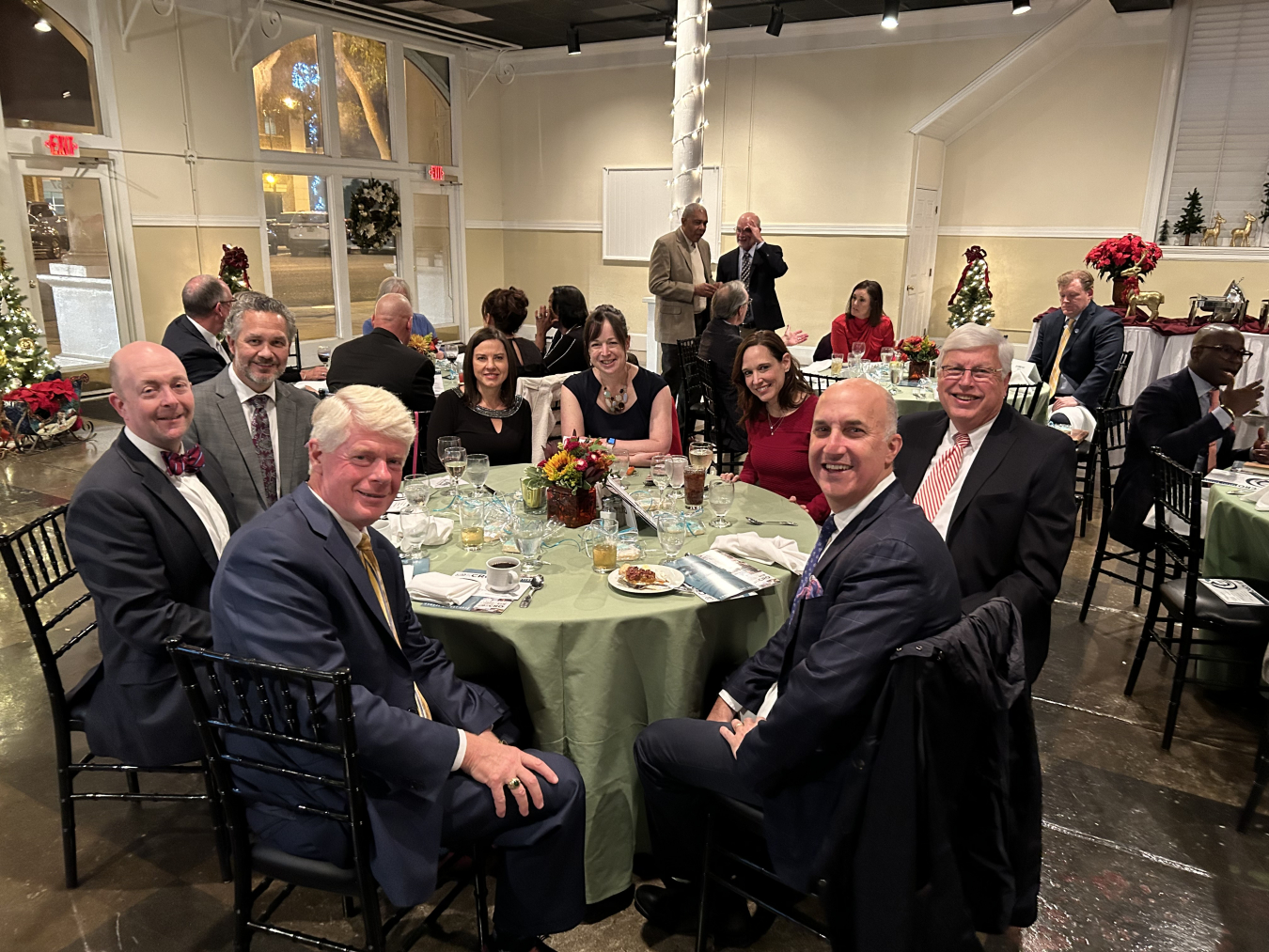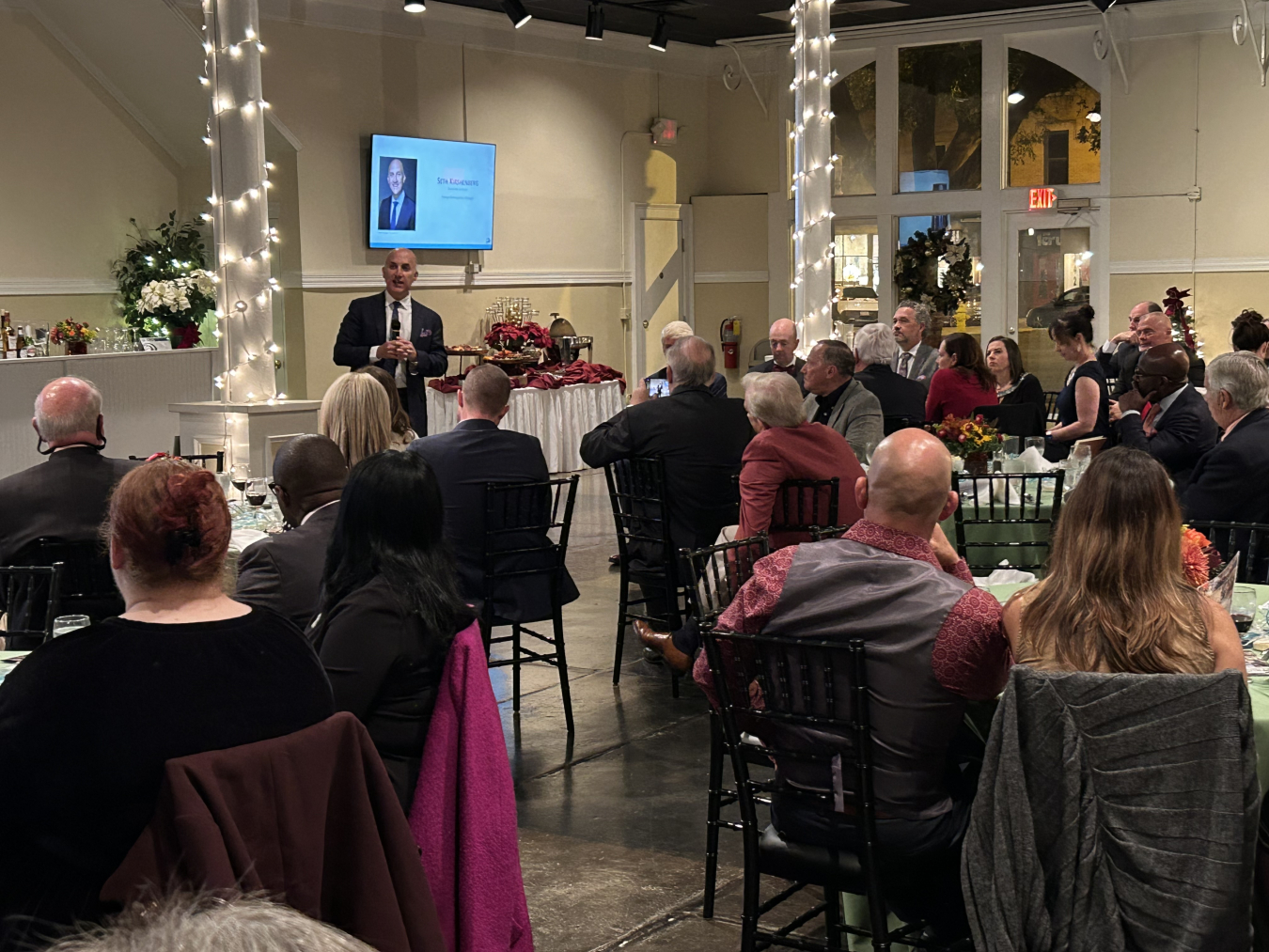A community reuse organization created to address challenges and job loss stemming from the end of the Cold War hosted its annual meeting recently to celebrate 30 years of success serving five counties around Savannah River Site (SRS).
Office of Environmental Management
December 12, 2023
Participants in the Savannah River Site Community Reuse Organization (SRSCRO) annual meeting included, clockwise from center, Kristen Ellis, associate principal deputy assistant secretary for EM’s Office of Regulatory and Policy Affairs and EM director of regulatory, intergovernmental, and stakeholder engagement; Kara Colton, director of nuclear policy, Energy Communities Alliance (ECA); David Jameson, president and CEO, Aiken Chamber of Commerce; Seth Kirshenberg, executive director, ECA; Mike Budney, manager, Savannah River Operations Office; Will Williams, chair, SRSCRO Board of Directors; Robbie Bennett, president and CEO, SRSCRO; and Trenney Bennett.
AIKEN, S.C. — A community reuse organization created to address challenges and job loss stemming from the end of the Cold War hosted its annual meeting recently to celebrate 30 years of success serving five counties around Savannah River Site (SRS).
Among the speakers at the SRS Community Reuse Organization (SRSCRO) meeting were Kristen Ellis, associate principal deputy assistant secretary for EM’s Office of Regulatory and Policy Affairs and EM director of regulatory, intergovernmental, and stakeholder engagement, and Seth Kirshenberg, executive director of Energy Communities Alliance. Both gave remarks on their experiences with SRSCRO.
“I’ve worked with the SRSCRO for more than a decade. Their management of the Workforce Opportunities in Regional Careers (WORC) grant has generated a tremendous return on investment for our workforce and for the region’s economic future,” Ellis said.
The EM-funded Advancing Nuclear Skills Regionally Grant and WORC grants have provided 2,514 scholarships to more than 1,677 students, according to SRSCRO. Many of these students have gone on to work at SRS.

During the 30th anniversary event, the organization’s officials thanked outgoing board members and recognized Will Williams for his service as chair. The theme of the evening was “Cultivating Remarkable Outcomes.”
The successes of SRSCRO are made possible by the vision set by SRSCRO Board of Directors, key partnerships with community stakeholders, and a staff dedicated to ensuring success, according to the organization.
As SRS began a mission shift from production to cleanup resulting in the loss of nearly 12,000 jobs following the end of the Cold War, SRSCRO was established to identify ways to help create job opportunities for those impacted by the downsizing. Economic diversification was the primary mission. Over the course of the next 30 years, SRSCRO leveraged its roles to support regional economic development and workforce development through collaboration and partnership.
The nonprofit group’s present mission is to facilitate economic development opportunities associated with SRS technology, capabilities and missions and to serve as an informed, unified community voice for the two-state region, which includes the counties of Aiken, Allendale, and Barnwell in South Carolina and Columbia and Richmond in Georgia.

Seth Kirshenberg, executive director of Energy Communities Alliance, provides remarks on his experience with the Savannah River Site Community Reuse Organization.
Through economic development support, SRSCRO has invested more than $16.7 million in startup businesses, economic development infrastructure, and community and workforce capacity building. This includes investing funds into five industrial parks across the two-state region.
Use of these funds by SRSCRO partners has enabled them to create 11,200 jobs and $5 billion in capital investment, and leverage more the $41 million in matching funds. And the group’s Asset Transition Program has saved SRS more than $12 million in cost avoidance.
In 2009, SRSCRO expanded its efforts to address the looming workforce challenge exacerbated by the retiring nuclear workforce. With a clear vision and new data, SRSCRO established the Nuclear Workforce Initiative. Through this program, the group established partnerships with EM and the National Nuclear Security Administration that would go on to provide more than $23.5 million in grant funding for new programs and student scholarships at local colleges and universities.
SRSCRO also focuses on the advancement of science, technology, engineering and math (STEM) education in the region. Through STEM Career Connections, it has reached more than 10,000 participants from 35 high schools in 11 counties. Since 2013, the efforts of SRSCRO and its regional partners have led to more than 96,000 participants with Nuclear Science Week programs and activities — an average of 30 events annually.
To receive the latest news and updates about the Office of Environment Management, submit your e-mail address.

